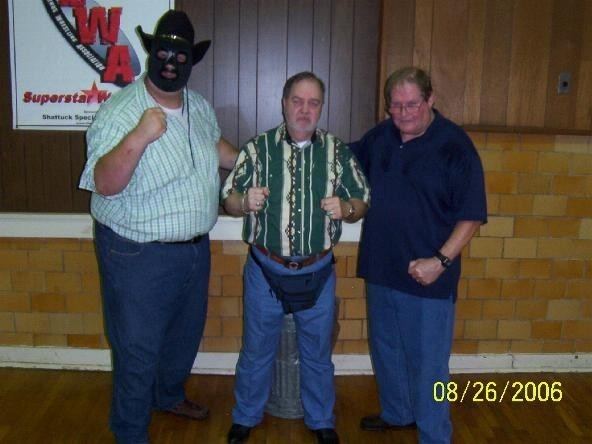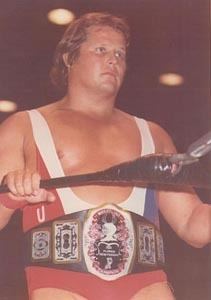Birth name Robert Michael Roop Billed weight 270 lb (123 kg) Debut 1969 Role Professional wrestler Children Jai Singh I Grandchildren Ram Singh I | Billed height 6 ft 2 in (185 cm) Name Bob Roop Height 1.85 m Movies Paradise Alley Books Death Match | |
 | ||
Born July 22, 1947 (age 78) Blacksburg, Virginia ( 1947-07-22 ) Ring name(s) All-AmericanThe EnforcerThe GladiatorMaya SinghMaha SinghStar WarriorBob Roop | ||
Bob Roop on Stretching Wannabees & More!
Bob Roop on Bruiser Brody
Robert Michael "Bob" Roop (born July 22, 1947) is a retired amateur and professional wrestler, whose career as a wrestler spanned high school, college, the United States Army, amateur and professional wrestling. He was an American heavyweight Greco-Roman wrestler at the 1968 Summer Olympics.
Contents
- Bob Roop on Stretching Wannabees More
- Bob Roop on Bruiser Brody
- Amateur career
- Professional career
- Later years
- Other media
- Personal life
- In wrestling
- Amateur wrestling
- Professional wrestling
- Published books
- References

Amateur career

Robert Roop began wrestling in the eighth grade in East Lansing, Michigan. In High School, Roop was varsity heavyweight as a freshman, with an inauspicious 0-22-1 record. With the guidance of coach Joe Dibello, his record improved in ensuing years, with a 27-0-0 record his senior year, in which he also took State Championship.

He entered Michigan State University on a football scholarship. After a year and a half, he left school to join the Army. He received paratrooper training, and signed on to become a Special Forces medic. He competed on the All-Army wrestling team and, later, the All-Services wrestling team. There was one other heavyweight on the All-Services team, Jim Rasher, who had won a bronze medal as the U.S. Greco-Roman Heavyweight at the World Games prior to entering the Army. Rasher was influential in Roop's decision to pursue an amateur wrestling.
After his three-year stint in the service, he entered Southern Illinois University, and began pursuing amateur wrestling. He attended from 1965 through 1969, majoring in political science, and was a collegiate wrestling standout with a win-loss record of 66-18, including a 16-3 record during his senior year.
While in college he won four National Amateur Athletic Union All-American rankings, earned by placing in the top four spots in the national tournament, and an NAAU Championship as a light-heavyweight. During his last year of college, his coach at Southern Illinois convinced him to train down to a lighter weight of 220 pounds. "That spring, I entered my last national tournament before turning pro, the national AAU at Greco-Roman at 220, and I won that one. It was the first one I even won. I had taken second and third a couple of times," Roop said. In 1968, Roop earned a position on the U.S. Olympic team as a Greco-Roman heavyweight.
Roop was 25 years old, 6 feet 2 inches (1.88 m) tall and weighed 270 pounds (120 kg) entering the Games in Mexico City in 1968. The team was coached by legendary wrestling coach Henry Wittenberg. Roop finished in seventh place, losing to Aleksandr Medved, who went on to win the gold medal.
Professional career
Roop began his professional career in 1969 after a meeting with his long-time friend Larry Heiniemi, better known as Lars Anderson. Heiniemi's tales of global travel and financial success appealed to Roop who began working for Eddie Graham, the promoter of Championship Wrestling from Florida. Working as an arrogant villain and flaunting his genuine amateur wrestling credentials, Roop challenged for the NWA World Heavyweight Championship on five occasions.
In 1976, Bob Roop received a possible career ending knee injury while wrestling Eddie Graham. The move which supposedly caused the injury, the figure-four, was banned as a crippling hold. While Roop was supposedly recovering, a new wrestler, The Gladiator, appeared on the Florida wrestling scene. The masked Gladiator used the shoulderbreaker, Roop's signature finishing move, and crowds shouted Roop's name when he appeared in the ring. During a Gladiator match on the Championship Wrestling from Florida TV program, Eddie and Mike Graham ran in on the match and removed the mask. The Gladiator was revealed as Roop. This incident is listed as number 24 in the CWF's "The Twenty-Five Greatest Angles In CWF History". After the unmasking, the figure-four was reinstated. This angle was used in 1977 in Roy Shire San Francisco NWA territory as Roop was "injured" by Kevin Sullivan and then a masked wrestler named The Star Warrior showed up around the same time Roop was injured; later, Sullivan unmasked Star Warrior, who was Roop.
Roop also wrestled for a time in Mid-South Wrestling and is often incorrectly credited for being the man who created the reversal to the figure four leg lock, the hold that "injured" him in Florida. Cowboy Bob Ellis used the maneuver against Buddy Rogers back in the early 1960s.
Roop later became part of the Army of Darkness stable which included Kevin Sullivan, Purple Haze, Luna Vachon and Lock, Kharma/Molokai and Fallen Angel. Roop adopted the ring name Maha Singh, shaving off the hair and beard on half his head and putting face paint on the shaved side.
Later years
Roop retired from wrestling in 1988 due to a neck injury suffered in a car crash. At the time he also handled booking duties and trained wrestlers at a school in Davie, Florida. An early student of his was Lawrence Pfohl, the future Lex Luger, who Roop broke into the business before turned over training duties to Hiro Matsuda. Looking back on his career in 2000, Roop stated "I had a hell of a lot of fun doing it, and it was quite an education."
Since retirement, Roop has lived in Michigan and worked as a Boy Scouts troop leader.
On July 15, 2006, Bob Roop was inducted into the George Tragos/Lou Thesz Professional Wrestling Hall of Fame. The ceremony was held at the International Wrestling Institute and Museum then in Newton, Iowa (now in Waterloo, Iowa).
Other media
Roop made a cameo appearance in the 1978 Sylvester Stallone movie Paradise Alley.
Personal life
Roop is married and has two sons.
